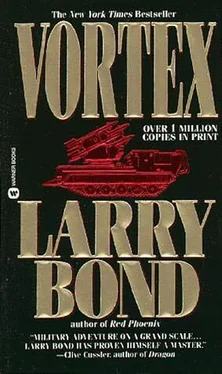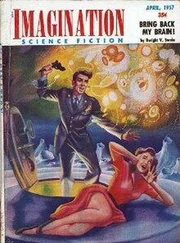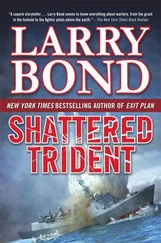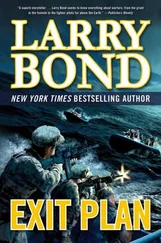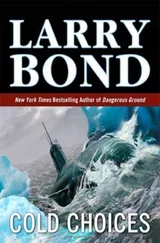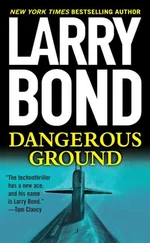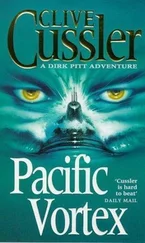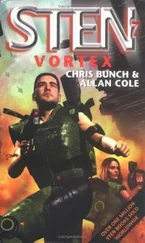Independence planned a coordinated alpha strike on key military targets scattered throughout the Durban area. So Comanche flight’s four A-6Es would orbit at a predesignated point until all the fighter and attack aircraft were launched. Both carriers were launching full deck loads-putting more than one hundred and twenty warplanes in the air.
The four planes of Comanche Flight quickly reached their holding point,
Sierra Twelve, and orbited slowly—circling round and round at low altitude. Night formation flying kept Hammond busy enough, but his bombardier navigator Rob Wallace, was even busier checking out the
Intruder’s complex electronic suite. Even with built-in test equipment, making sure everything worked took a while.
“This is Overlord. Execute. ” The order to move came after only a few minutes. Watching his flight leader carefully, Hammond followed his movements automatically, without radio conversation.
The four attack jets had been orbiting at two thousand feet, but now they eased down to a tenth of that as they made their run in toward Durban.
Hammond felt his heart pounding faster. This was for real. They’d been assigned to take out the 20mm and 30mm antiaircraft guns ringing Louis
Botha Airport.
About twenty miles out from the shoreline, the Intruder’s thermal imager started picking up buildings and other heat sources. The heat-sensitive
TV camera allowed them to navigate and find their target in total darkness. The camera didn’t need light, just heat.
As they closed the beach, taller structures appeared, and bright, glowing spots appeared on the screen. Hammond squinted at the screen. Fires? He nodded to himself. Yeah. Big ones burning out of control. Set by other strikes, maybe. Then he realized that they were too widespread and too well developed. The city was already burning.
It looked as if an invasion could only improve things.
USS MOUNT “ITNEY
Silhouetted against the rising sun, Lt. Gen. Jerry Craig leaned over the rail, staring through binoculars at the crowded ships steaming slowly to either side. Helicopters and other aircraft were already spooling up, engines howling across the water. A strong offshore breeze tugged at his jacket, whining through the Mount Whitney’s massive arrays of radio antennas and satellite dishes.
By rights he knew he should be down in the ship’s comfortable, computer-display-lit Fleet Command Center. But he couldn’t resist the chance to take one last look at the forces under his command.
“Sir?”
Craig turned to find a Navy lieutenant commander standing behind him.
“Yes, Commander?”
“General Skiles wanted me to tell you we’ve gotten word from the Vinson.
Our initial air strikes are complete.” The Navy officer’s face broke into a sudden smile.
“We pounded the hell out of ‘em, sir.”
Craig nodded.
“Good.” He headed for the ladders leading down to the command center.
“Signal all ships. Land the landing force.
USS SAIPAN
Columns of heavily armed Marines were still climbing aboard their waiting planes when the order came to launch. Barely heard over the howling rotors and jet engines, cursing sergeants and officers of all
ranks hurried the camouflaged soldiers aboard. Men piled into seven Ospreys at the run. And as their hatches slammed shut, the heavily loaded troop carriers skittered forward and off the deck, their rotors straining to pull them skyward.
Even as the first wave of aircraft lifted off, the Saipan’s elevators brought up another set, which taxied into takeoff position. With well-practiced movements, more men emerged from the island and in snaking columns trotted up to their assigned aircraft just as they reached position.
The evolution was being repeated on the USS Wasp and Inchon. Clouds of fighter and attack aircraft covered them as twenty-one Ospreys orbited, assembling, then turned and headed inland.
Skimming the wavetops at almost three hundred knots, the formation hurtled toward the smoke-shrouded beach. Troops in the cargo compartment sat strapped in, facing each other on crash-proof seats, but they still had to hang on as the Ospreys plowed through the bumpy, low-altitude air.
The Osprey pilots, most of them converted over from the old Sea Knights helicopters, looked out to either side, gratified to see loaded attack aircraft and armed fighters pacing them.
When riding shotgun, the “fast movers” normally looped over and around helicopter troop carriers, but the Ospreys were fast enough to keep up with a cruising jet. That made for tighter control, better support, and a warm, fuzzy feeling for the Osprey drivers. Higher airspeed also meant the vulnerable troop carriers were exposed to enemy flak for a much shorter time.
In fifteen minutes, five of them spent assembling, the assault formation was over the Louis Botha International Airport. Over, in this case, was a relative term, since the Ospreys came in low and hot-screaming in no more than a hundred and fifty feet off the ground.
As their wings tilted upward to vertical flight mode, the Ospreys bucked and shuddered-dumping speed. In less than a minute, three-hundred-knot turboprop planes became fifty knot helicopters, gently settling down on the runways and taxiways and any other paved areas. The second their gear touched down, rear ramps dropped and Marines poured out onto the airfield.
They fanned out across the tarmac in an almost eerie silence broken only by whining rotors, shouted commands, and crackling flames. Nobody was shooting at them.
The airport’s antiaircraft batteries and ground defenses had been thoroughly pasted. A-6E Intruders dropping dozens of five-hundred-pound bombs had turned them into crater-rid died smoking piles of torn sandbags and mangled metal. Now orbiting AH-I Sea Cobras and Harriers waited for any sign of serious opposition, but columns of thick black smoke billowing into the air were the only signs of movement.
Despite the terrific aerial pounding it had taken, however, Louis Botha’s runways were still intact. The Allied invasion force had uses for them.
Empty now, the Ospreys lifted off, buzzing low over abandoned factory buildings and warehouses as they headed back to the formation, fifty miles distant, to pick up the second wave.
The freight-train roar of heavy artillery broke the silence. Shells began bursting among the Marines scattering across the open tarmac-exploding in huge fountains of earth and flame. Three batteries of Afrikaner guns pounded the airport mercilessly, killing American Marines with every carefully directed salvo.
USS MOUNT WWITNEY
Craig stared at the computer-generated map, wishing it were a wide-screen
TV. He wanted to see what was going on. Trouble was, if he left the Mount
Whitney, he wouldn’t be able to do his job. The ship carried the sophisticated communications and computer systems he needed to control all his forces-those already onshore and those still waiting to hit the beach.
“How bad is the shelling?” he asked Skiles.
“Hayes says his men are completely pinned down. He’s taken moderate to heavy casualties. He also reports that the LZ’s way too hot for the second wave.”
Craig nodded.
“I concur. Hold the second wave twenty miles out, and let’s see what we can do about the artillery.”
“We’re getting nothing on radio intercepts,” Skiles reported.
“We don’t know where the guns or the observers are. 11
Skiles scribed a forty-kilometer arc on the map, centered on the airfield. Craig sighed. The damn guns could be two thirds of the way to
Pietermaritzburg. It was rough country, far too big an area to search.
Thinking out loud, Skiles said, “They must be using landline, regular telephones to communicate. In a big city like that, they’ve got a built-in secure communications system.”
Читать дальше
